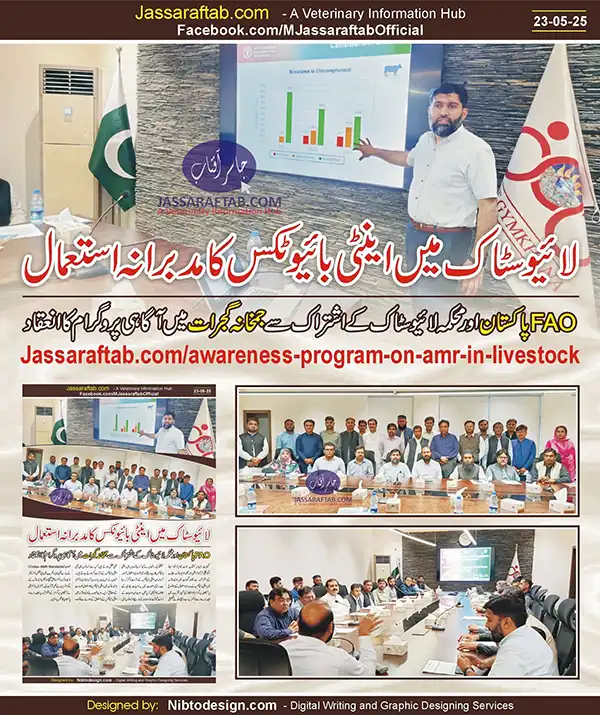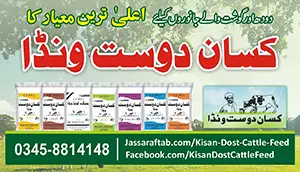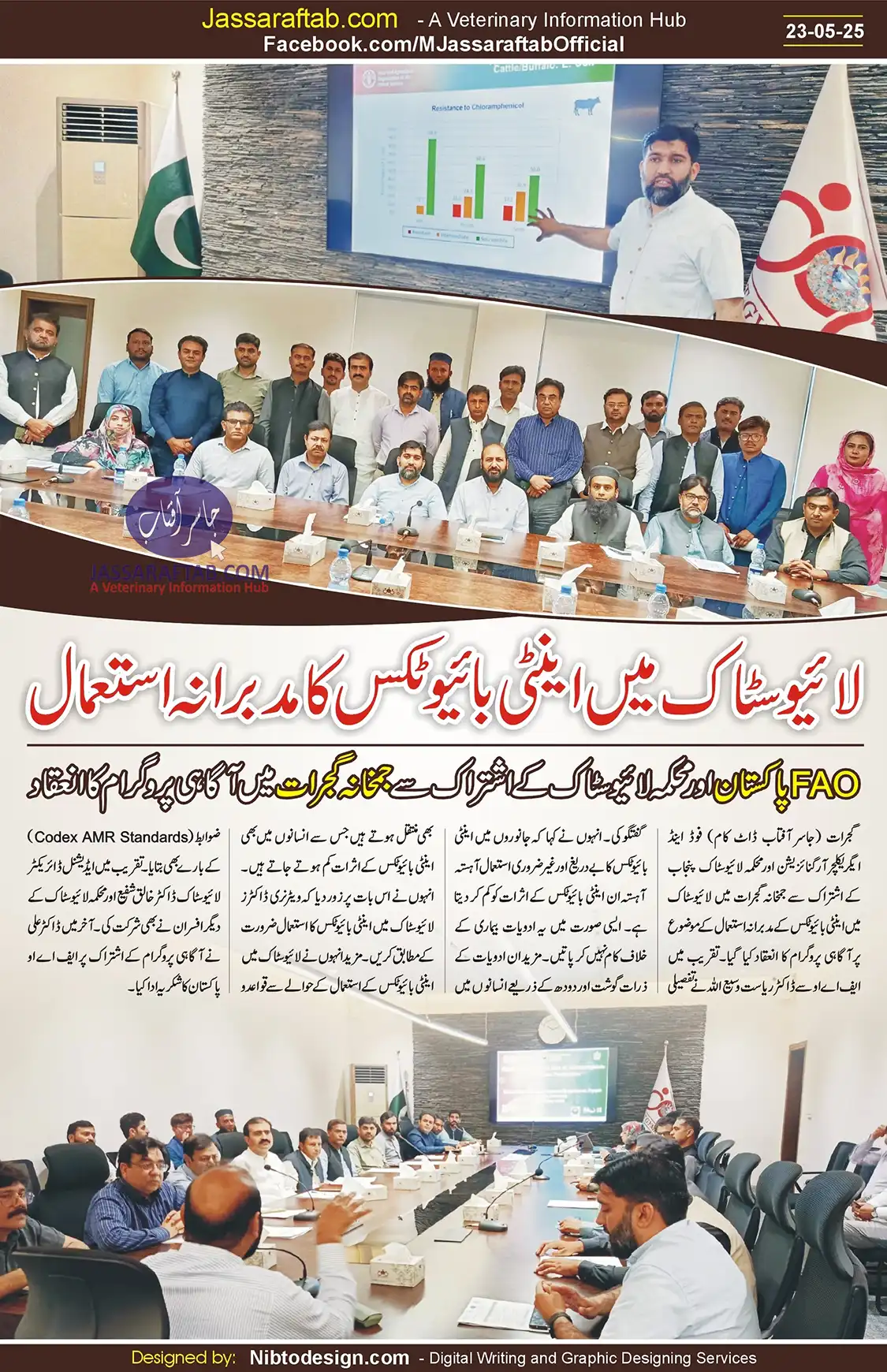
Awareness Program on AMR in Livestock held at Gymkhana Gujrat
An awareness program on the judicious use of antibiotics in livestock was organized at Gymkhana Gujrat in collaboration with the Food and Agriculture Organization and the Livestock Department of Punjab. Foodborne AMR, AMR in Livestock (Antimicrobial Resistance in Livestock), Drug Residues in Livestock Products, AMR Codex Standards, and other aspects were discussed.
Dr. Khaliq Shafi, the Additional Director Livestock Gyhrat, Dr. Ali and other officials of the Livestock Department Punjab also joined the program.
Dr. Riyats Waseelullah from Pakistan spoke in detail to FAO at the event. He said that the indiscriminate and unnecessary use of antibiotics in animals gradually reduces the effects of these antibiotics. In such a case, these drugs do not work against the diseases. Moreover, the drug residues are also transferred to humans through meat and milk, which produces antimicrobial resistance in humans.
The Rising Concern of AMR in Livestock
Antimicrobial Resistance (AMR) refers to the ability of microorganisms to resist the effects of drugs. This resistance arises mainly due to the overuse and misuse of antibiotics in humans and animals. AMR in Livestock (Antimicrobial Resistance in Livestock) is also a serious concern as it affects humans in the context of foodborne AMR.
Dr. Riyats Wazeelullah explained that the indiscriminate use of antibiotics in animals compromises the efficacy of these drugs. When animals are regularly administered antibiotics without a proper clinical need or veterinary oversight, bacteria in their bodies can develop resistance. This resistance can then be transferred to humans through the food chain, primarily via meat, milk, and other livestock and poultry products.
Foodborne AMR and Drug Residues in Livestock Products
Foodborne antimicrobial resistance (AMR) is an emerging public health concern that occurs when resistant bacteria are transmitted to humans through the consumption of contaminated livestock and poultry products. Overuse or misuse of antibiotics in livestock makes the bacteria resistant and they survive in animals. These bacteria contaminate milk, meat eggs, and other livestock products.
Dr. Riasat Waseeullah also discussed the problems of drug residues in livestock products. Drug residues are the small amounts of antibiotics that remain in animal tissues (such as muscle, liver, or milk) after treatment. When proper withdrawal periods (the time between the last drug administration and when the animal product can be safely consumed) are not observed, these residues can enter the human food supply.
Consuming such residues can cause allergic reactions in sensitive individuals and also contribute to antibiotic resistance in the human population. Resistant bacteria or residual antibiotics can influence human gut microbiota and make the common antibiotics ineffective over time. So Antimicrobial Resistance in Livestock is a serious public health concern.
AMR Codex Standards and AMR in Livestock
The program emphasized the importance of implementing the Foodborne AMR Codex Standards. These standards were developed by the Codex Alimentarius Commission. It was the joint initiative of the FAO and the World Health Organization (WHO). These guidelines provide internationally recognized practices to:
- Control the overuse of antimicrobials in food-producing animals.
- Encourage responsible veterinary practices.
- Establish risk-based control measures for antibiotic residues in food.
Dr. Riasat Waseeullah urged veterinarians to prescribe antibiotics only when necessary, based on a confirmed diagnosis. He also emphasized following proper dosages and withdrawal times.
Compedium of AMR Codex Standards








8 Comments
You can shelter yourself and your ancestors by way of being heedful when buying panacea online. Some druggist’s websites function legally and sell convenience, reclusion, cost savings and safeguards for purchasing medicines. buy in TerbinaPharmacy https://terbinafines.com/product/atarax.html atarax
More articles like this would remedy the blogosphere richer. TerbinaPharmacy
Thanks on sharing. It’s outstrip quality.
Đến với J88, bạn sẽ được trải nghiệm dịch vụ cá cược chuyên nghiệp cùng hàng ngàn sự kiện khuyến mãi độc quyền.
搭载智能站群程序,自动化搭建与管理,为SEO项目提供核心驱动力。站群程序
iwin – nền tảng game bài đổi thưởng uy tín, nơi bạn có thể thử vận may và tận hưởng nhiều tựa game hấp
I in addition to my buddies have been looking at the good tips and hints on the website and so all of a sudden got a terrible suspicion I had not expressed respect to the site owner for those techniques. All the young men came excited to read all of them and already have in actuality been taking advantage of these things. Thanks for being indeed accommodating and also for pick out certain magnificent subjects most people are really wanting to learn about. My sincere regret for not expressing gratitude to you earlier.
Just about all of what you assert happens to be astonishingly appropriate and it makes me wonder the reason why I had not looked at this in this light previously. This article truly did turn the light on for me as far as this issue goes. Nevertheless at this time there is actually 1 issue I am not really too comfortable with so while I try to reconcile that with the actual central idea of your point, let me see exactly what the rest of the readers have to point out.Well done.